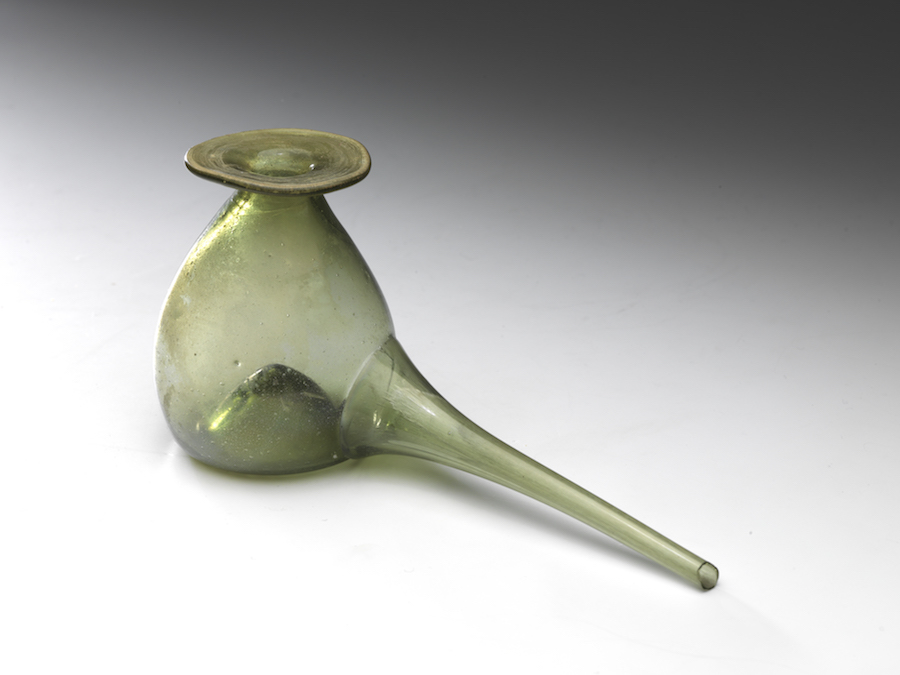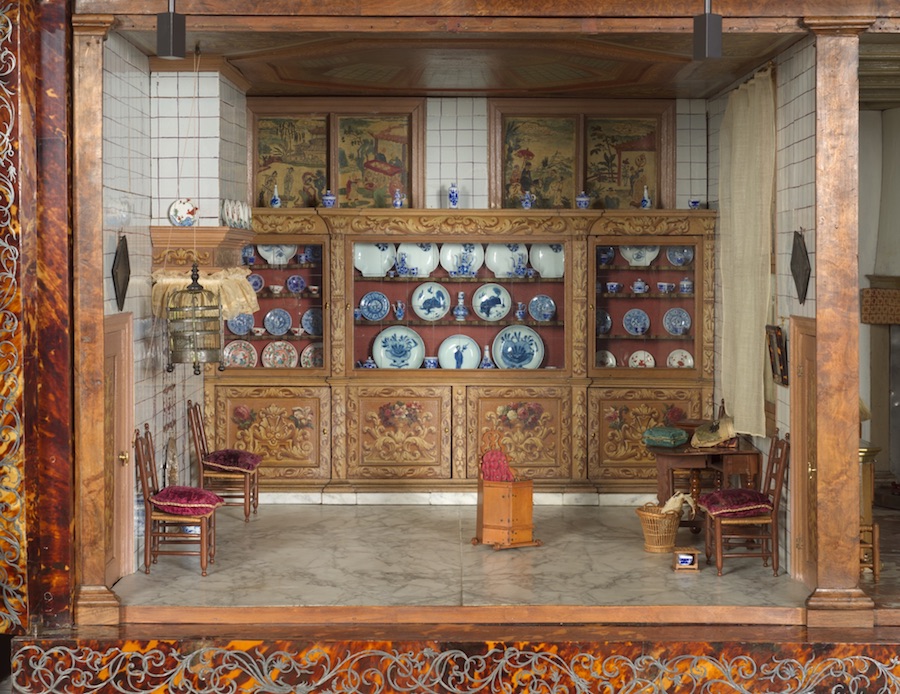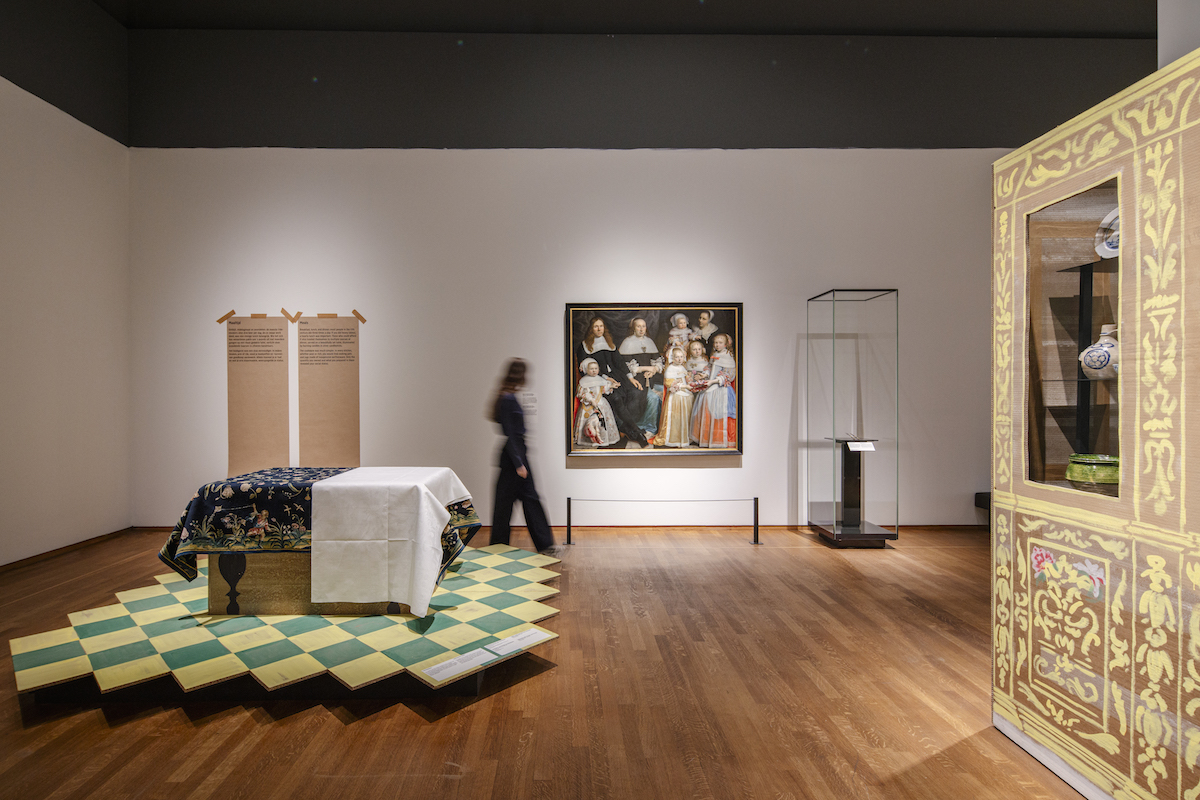The exhibition At Home in the 17th Century at the Rijksmuseum seems like a humble enterprise on one level. It may once have been considered rather a stoop for the national museum, but this exhibition on domestic interiors is curatorially ambitious on quite a few levels.
It includes and encourages new research, even archaeological digs, not simply excavating its own archives. Multiple curators have worked separately and together, and an archaeologist has been appointed. One of the major sources of new finds was the Sonck family cesspit, which, unusually for a time with communal cesspits, has revealed items and information relating to a particular family. The exhibition has put these on display in an entertaining and theatrical way, and there are many standout items that shed new light on the home life of high-middle-class family life in the Netherlands in the Seventeenth century. However, some of them were displayed so high that they could be hard to see, and I think that was a problem with this fascinating display.
Some of the significant finds are really worth viewing. They would be of interest to many contemporary artists who are developing new work that resonates with these kinds of domestic objects. I was reminded of the work of certain artists in my circle, such as Julia Maddison, Natalia Zagorska-Thomas and Caroline Gregory. I think this show is happening at a very well-selected time to relate to contemporary art interests and practice.
The domestic interior shows the bourgeois housewife as having great agency, being a mistress of her domain, and practising home economics. This was demonstrated in one particular piece, the metal girdle with chains attaching the keys of the closet and the house to a belt. This was a symbol of her power, although the chains did have a sinister connotation for a contemporary viewer.

Many of the pieces related to child-rearing showed unexpected differences and similarities in practices between then and now. The glass breast pump was a surprise to many, especially for shedding light on the pressures on women of the period to feed their own babies. The curator informed us that women’s breastmilk was considered to have qualities of the mother contained within it, so for those concerned with the family line, it had an extra significance to feed a child in this way. Breast is best had an extra ring with this belief.
The objects show an urbanised society of wealthy merchants concerned with child and mother health. A surprise cesspit find was a vaginal douche shaped like a penis, made beautifully out of wood. Called an irrigator in English, it sprayed cleaning fluids internally, an important cleaning facility when washing the body was less frequent than nowadays. The linen underwear, manufactured in the Netherlands, was often changed in wealthy families who could afford multiple garments, which helped maintain better hygiene levels. Lice combs and toothpicks were on display and were also worn as dress accessories.
Items from the nurseries included a baby’s whistle and rattle made of gold and rock crystal. A heavily carved layette cabinet for linen and nursery items was carved with items that were important in these special rooms, such as cradles, scissors, wicker baskets and feeding equipment. Perhaps this does not sound impressive, but the size, depth, and quality of these carvings made this unusual.
As an artist, I was fascinated by unfamiliar material processes and surface design – gilded leather wall coverings and cabinets veneered with tortoiseshell embedded with pewter. Floral motifs were common, reflecting the interest in horticultural science in the society of the time.
The exhibition’s lighting reflects the crepuscular environment of the seventeenth-century domestic interior. The religion of the time was Protestant, the dominant church was the United Reform, but there are representative items from the Portuguese Jewish community in the Netherlands, such as the pots that reveal the use of olive oil as a primary cooking ingredient, considered unusual for this time. This is one of the assumptions that is being challenged by this show.

The Doll’s House of Petronella Oortman is a valued centrepiece of the exhibition – not a toy for children but an educational aid for bourgeois girls, a demonstration of wealth, and an exuberant expression of the love of interiors at this time. Oortman’s Doll’s house was already famous as a work of art in the 17th century. This luxurious, well-furnished house shows a society less interrupted by civil war and religious conflict than the UK, allowing an aspirational imperialism to flourish in the domestic scene earlier. The porcelain pottery from China, the tortoiseshell, and the Japanese silks echo the sensational interiors of the 19th-century English country house. The Rijksmuseum have created an online experience to guide visitors through this miniature world that all can access remotely, continuing the educational purpose of the original object.
Although there are paintings of the families – and a personal favourite is the one showing the baker and his wife managing the store – the objects are the chief conversation points of this exhibition. They are stimulating to even those like myself who do not consider themselves especially interested in the history of the home. On the press trip, unusually, there were novelists and writers outside of traditional art history, including Jessie Burton, whose bestselling ‘The Miniaturist’ was available alongside the catalogue in the museum shop, showing the show’s crossover appeal.
This is a show that has an academic and educational mission, and this feels very much at the centre of what has been achieved. It’s obviously an important exhibition for academic research and actively contributes to understanding domestic history. It is a shame that it could not be more accessible, as many items felt rather high and difficult to see, which feels odd in such a family-focused exhibition. But it is an extraordinarily stimulating experience in this age of revived interest in domestic history, giving new information and showing new-found exhibits as well as little-seen pieces from the Rijksmuseum collection in a considered and well-organised display.
At home in the 17th Century, Rijksmuseum, Amsterdam, 17 October 2025 – 11 January 2026
Visit Here

